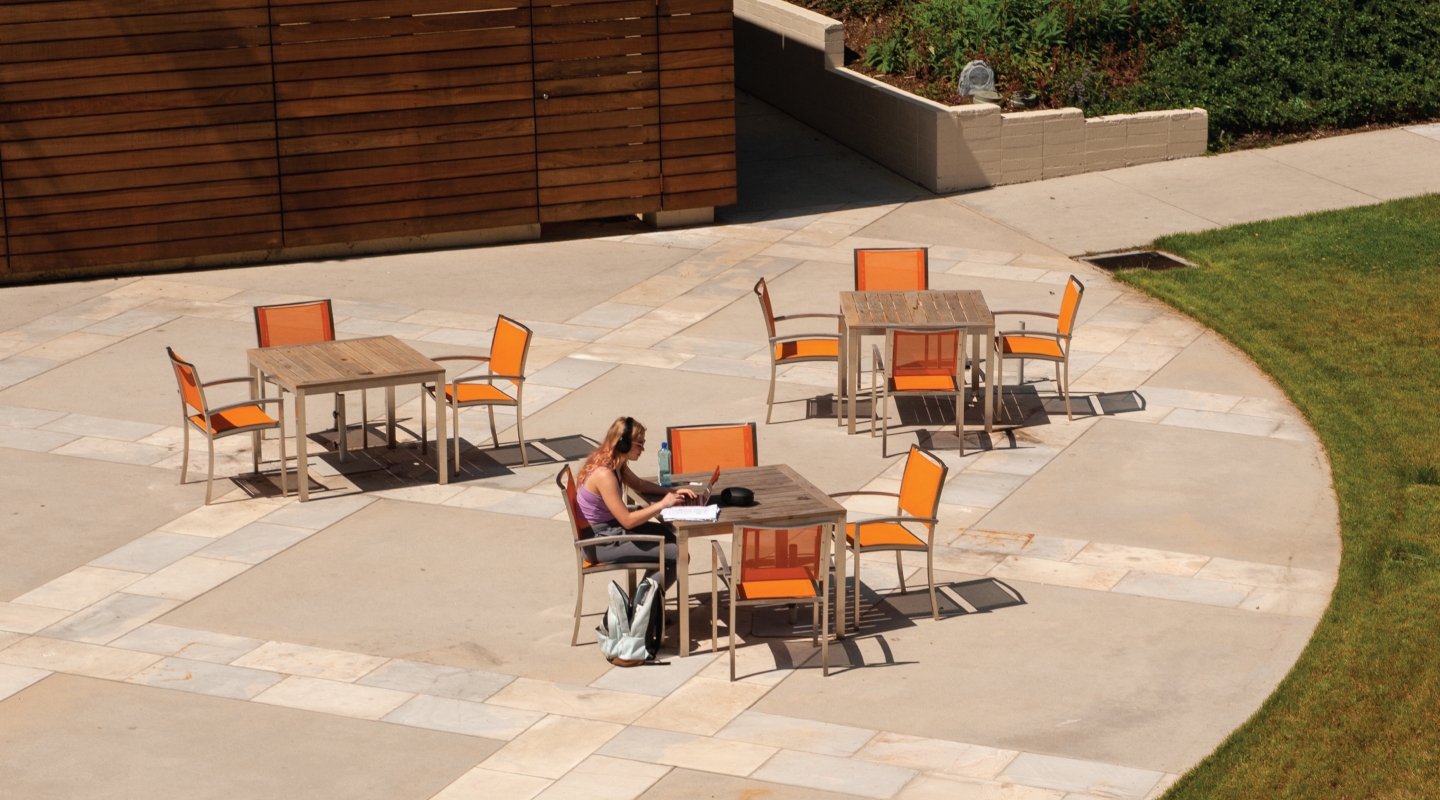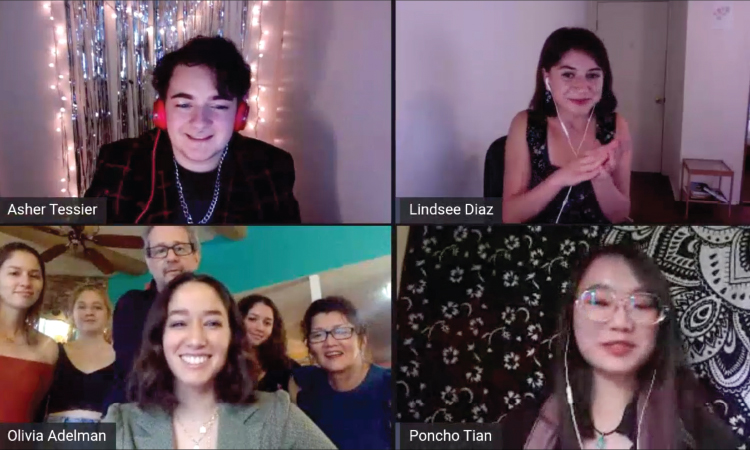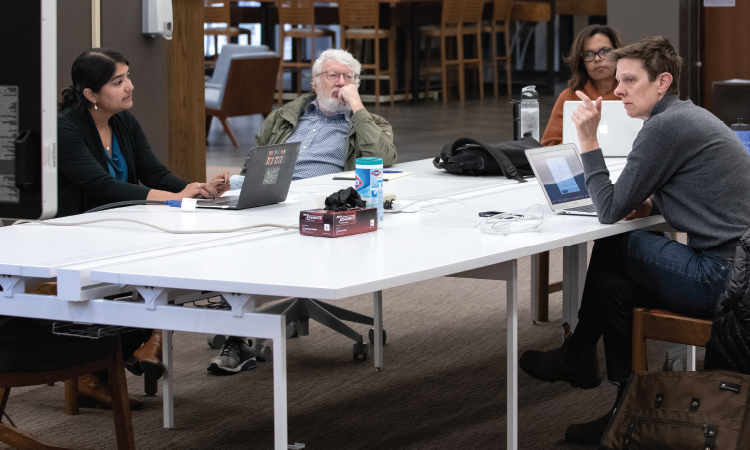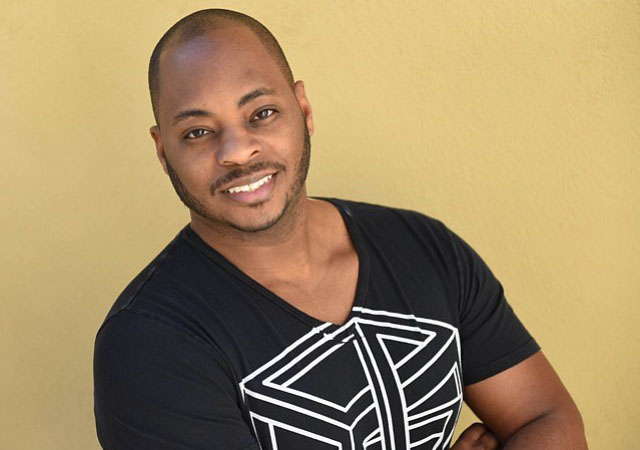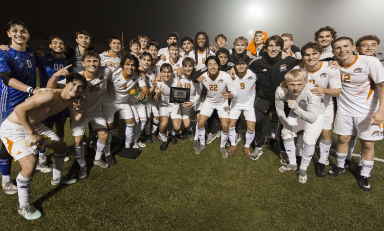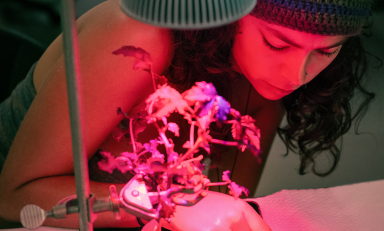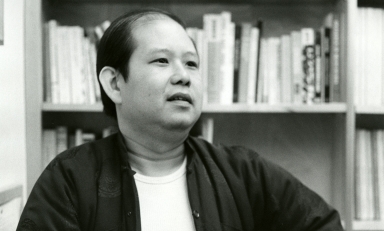In a race against two calendars—academic and pandemic—how did Oxy transform in less than two weeks from a high-touch curriculum to a remote learning model?
“Hello from Rat Graveyard,” Ben Smith ’20 writes, and classmate Lindsee Diaz smiles and waves from her home in National City, some 130 miles away. “We have a lot of weird [off-campus] house names around Oxy,” Diaz explains to the YouTube audience for the live preshow to the 2020 Media Arts and Culture Production Comprehensives—a virtual film festival showcasing the work of 13 MAC seniors. “It feels really great that we can still do this, and I’m very thankful that now people who maybe couldn’t watch it previously can now tune in. So, that’s awesome.”
“Thank you to everyone who is watching far and wide,” adds co-host Asher Tessier ’20 from his home in Thorndike, Mass. “This is not what we anticipated doing.”Nearly two hours later, when the credits rolled on the last student film, close to 200 viewers had tuned in—and the festival became the most visible manifestation of the swift turn of events that swept through the Oxy academic calendar this spring. Classes and lectures and comps had gone digital, and remote learning—while not a full-blooded substitute for the campus experience—had demonstrated the ability of students, faculty, and staff to roll with the changes.
The April 18 livestream was the handiwork of Diana Keeler ’09, Oxy’s manager of digital production, who worked remotely with the 13 production seniors in her Advanced Editing class in the weeks leading up to the festival just to get their films finished on time. “The idea was to create a virtual event that had different elements—a premiere of their films, a place viewers could comment, and a digital program in one place,” she explains. “We wanted it to be a synchronous screening where people all over the world could be watching simultaneously, so we set it up as a YouTube premiere with a countdown to a show that we could all watch together.”
“I have been looking forward to the MAC screenings in Thorne Hall since I was a first-year,” Diaz admits during the preshow. “But you know what? This is the new age … and I’m feeling good, frankly.”
For students in Oxy’s 44 majors and minors, the College’s foray into remote learning officially began March 23, following an extended spring break. But for James Uhrich, vice president for information technology services and chief information officer, and his team, the process began before there was even a COVID-19. “It’s hard to know where to start,” Uhrich says in an interview April 9. “It’s been such a circus and arguably still is.”
So, let’s begin at the beginning: A small group of senior administrators had worked during the fall 2019 semester on outlining what resources were available at the College as related to academic continuity planning. “We knew the College had to have plans in place for regular emergency preparedness—how we would be able to deliver remote education for a week or 10 days in the event of an earthquake or other natural disaster,” says Uhrich. In January, he shared a framework of available resources as well as what Occidental would need to continue instruction with the Emergency Operations Committee.
As the coronavirus situation began to develop earlier this semester, he adds, “We realized we had to take those plans and make them happen.” When Wendy Sternberg, vice president for academic affairs and dean of the College, updated faculty about academic continuity planning in a March 3 email, “At that moment we went from a shared set of documents for internal planning purposes to a situation where we knew this was not theoretical anymore.”
In moving 200-plus faculty and over 2,000 students online, “The biggest challenge was not making sure that the system worked—it was making sure the system worked for each faculty member’s classes based on the way that they teach,” says Uhrich, who joined the College in 2010. “It was an unprecedented volume of work, more than I’ve ever experienced in my two-decade-old career.”BlueJeans—a video conferencing platform the College has used since 2013—“was one of the resources on our emergency planning list, one of the five or so apps we knew would be central to maintaining our continuity of education,” he explains. (It also didn’t have all the bells and whistles that the situation called for, which is why the College has augmented it with Zoom—the video app equivalent of Coke to BlueJeans’ Pepsi.)
Working with the newly formed Academic Continuity Execution (ACE) team, “I could not have asked for a more responsive and helpful support system,” says Peter Dreier, the E.P. Clapp Distinguished Professor of Politics, who is teaching two politics courses—Urban Politics and Policy and Democratic Socialism—this semester. In addition to doing test runs using BlueJeans in advance of his first class, he says, members of the library team were extremely helpful in making e-books available to his students and digitizing several films for his courses so students could watch them at home.
“I’ve gotten quite a few emails from students saying that they enjoy the class,” Dreier says. “Attendance has been excellent so far. In fact, more students ‘show up’ for class than they did during the first half of the semester. Also, more students actually participate in the class discussion. I think they are relieved to have some kind of normal activity every day by attending the class sessions and are more likely to participate.”
Students in a BlueJeans session of Tom Burkdall’s Writing on Travel class were transported to the virtual classroom through photos taken by Helena de Lemos, Special Collections instruction and research librarian. From their homes, students examined images spanning from the 18th to the 21st centuries culled from Oxy’s Special Collections and College Archives—locales ranging from England’s Lake District to Yosemite National Park. “Helena talked about the context of the materials,” says Burkdall, associate professor of writing and rhetoric. “It was a great exercise in bringing historical elements to courses, no matter where everyone is.”
“One of our guiding principles on the academic continuity planning team has been we will do everything we can to get faculty and students whatever they need to successfully deliver the curriculum,” Uhrich says. Regardless of their role, “Everyone has a singleness of purpose and the goal of keeping Oxy vital and operating, and that shared purpose is bringing people together in ways I haven’t seen.”
Twice a week, music production instructor Jongnic “JB” Bontemps uses a new video platform called Panopto to record his lectures from his home studio. “Panopto is great in that it captures both video of me and my desktop and combines it all into one video feed,” he says. “It’s much like the classroom experience—students can see me and watch what I am doing on screen.” An added feature of the platform is the ability for students to rewatch or rewind the lessons if they didn’t get something the first time.
Bontemps augments the Panopto lessons and discussions on Moodle (an online platform) with weekly Zoom sessions where the class can interact more directly. “Students learn so much from each other’s questions,” he says. “It’s an important part of their learning.”For Kathryn Leonard, professor and chair of computer science, the move online has not changed her approach to her lessons for the two classes she is teaching this spring, even if it has changed their delivery. “I have students in almost every time zone for the junior seminar class [Second Stage Writing], so that class has moved to asynchronous—I post activities for them to do on their own schedule,” she says. “For the research course, I’m meeting with students in their subgroups—and each week, one subgroup posts a video presentation of their project status on a Slack channel that we all belong to, and the rest of us can ask questions and make comments.”
Leonard shares her teaching space with two cats, “who ignore me until I’m talking on a video call—then they desperately need my love and affection. But I like those interruptions—it always lightens the mood.”
Before spring break, Nalsey Tinberg reached a milestone—even if she didn’t realize it at the time. “Unknowingly I had taught my last ‘in-person’ class, and that was a moment for me,” says the longtime professor of mathematics, who joined the Oxy faculty in 1980 and is taking a sabbatical year prior to her official retirement in August 2021.
Working with Jacob Sargent, training and support team lead for ACE, Tinberg got a tutorial in BlueJeans and Zoom for conferencing. The most challenging thing about adapting to distance learning, she says, has been “adjusting to the technology while trying to maintain the same kind of classroom structures and interactions.”
In lieu of day-to-day assignments in her Calculus 1B and Linear Algebra classes, “I have gone to set our weekly expectations so that students have a bit more freedom,” she adds. “I don’t know the pressures they are under from other classes or family issues.”
Teaching from her home office, which is also her guest room, Irene Girton has embraced the demands of remote learning with a vigor that belies the fact that this is also her last semester in the classroom. “In anticipation of my upcoming departure from teaching, I had just recently downsized my desk to a much smaller one—not great timing,” says the professor of music, who has taught at Oxy since 2000 and is also on sabbatical next year. “I have an old Steinway upright that’s an OK substitute for the wonderful grand pianos I’m used to using in Booth 204, and all the online media I’ve always used in class are still available to me.”
In adapting to remote learning, Girton reconciled the balance between teaching specific compositional and analytic skills and techniques, “which are very time-intensive and require considerable one-on-one attention,” and presenting broader theoretical concepts by creating video presentations relating to those specific skills and techniques.
“If I teach music theory to students as a way of thinking about music—with clarity, specificity, and in cultural, historical, technical, aesthetic, and emotional context—then I’ve done the best job I can do,” she says.
In “this brave new virtual world,” Sophal Ear, associate professor of diplomacy and world affairs (DWA), feels he has come close to replicating the in-person classroom experience. Livestreaming back-to-back sections of his Introduction to Global Political Economy—a required class for DWA majors—Ear has seen a boost in attendance from earlier in the semester, when he was teaching his class in Johnson Hall 314, one of the balcony rooms above Choi Auditorium. “It takes incredible concentration when you are focused on a computer screen trying to sound erudite and witty, but also thoughtful and deep, all while delivering your slides and trying to engage students whose faces you don’t all see,” Ear says. Because he can’t stand up and walk around the classroom, he adds, after nearly three hours at the computer, “You are extremely sorry you did this to your back.”
COVID-19 has already found its way into his syllabus. “My first class was supposed to be about behavioral and institutional critiques of liberal political economy but ended being mostly about the political economy of COVID-19,” he says. “I think every class will have a bit about that. It’s inescapable.” (It’s also the topic of his third book manuscript: Viral Sovereignty and the Political Economy of Pandemics: What Explains How Countries Handle Outbreaks?)
The pandemic has found its way into other class curricula as well. For Health and Humanity, an eight-unit course in Oxy’s Cultural Studies Program that uses interdisciplinary tools to study various elements of health and medicine, professor Kristi Upson-Saia (religious studies) and associate professors Brandon Lehr (economics) and Clair Morrissey (philosophy) pivoted away from the content they had planned prior to COVID-19 and asked students to analyze the pandemic using the skills they had learned prior to spring break. In the following weeks the professors broadened their gaze to the history of pandemics dating back to the ancient Mediterranean.
Not every class can be translated to virtual work. Absent the ability to do hands-on experiments, Professor of Biology Roberta Pollock’s Bio 395 students spent the remainder of the semester “talking about their project, our data, and where we were going,” she says. “It was a huge disappointment.” Although it was no substitute for in-person presentations, many of her biochemistry seminar seniors completed their comps by posting their presentations online.
Despite the physical challenges of remote learning, Pollock says, “The pandemic has brought us closer together. It seems easier for many students to meet virtually rather than having to come to my physical office. It helped me personally to be able to help them.”
“Even with all the challenges and obstacles in their way, all 13 of my seniors not only finished their comps projects but excelled in their execution,” Keeler says of her MAC production students. “They told me how they had a group chat going, and they weren’t going to let anyone slip through the cracks, especially not after coming this far. While they might be miles apart now, their Oxy community spirit is strong, and it’s for them that I try to give my best every day.”
Ear concurs. “We are all apart and yet we are sharing space we would never have on campus. A cat sneezes. There’s a huge library of books in the background of one student’s video shot, and in another there’s artwork that a student’s mom got from Africa. We are all experiencing the same dislocations. They may be back in their childhood bedrooms, but I’m also broadcasting from my bedroom.”

